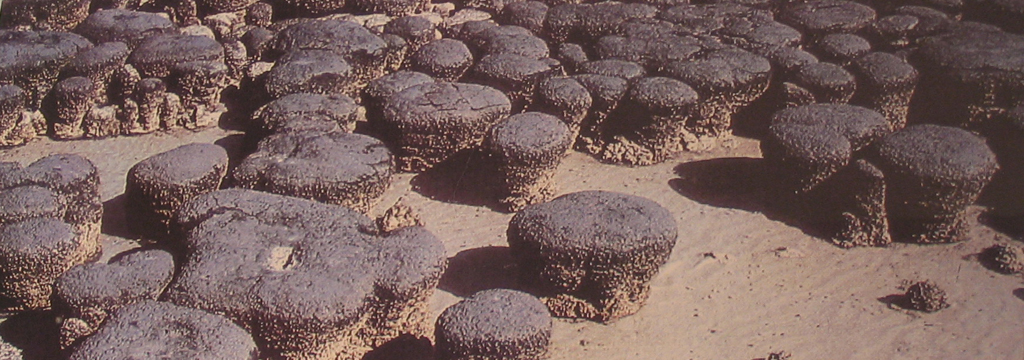
PROKARYOTES
Classification
[Photo taken at KUNHM]
Chapter Outline
- Description of Prokaryotes
- Classification of Prokaryotes
- Bacteria
- Archaea

Links to external sites will appear in pop-up windows.
There are approximately 5,000 species of prokaryotes known, but there are between 400,000 - 4 million estimated. Since the methods used to study prokaryotes are more complicated and more expensive than those used to study many other living things, far less is known about them. What has been discovered about prokaryotes has shown them to be both important and diverse.
Two of the three major divisions of living things, called domains, are prokaryotic: Bacteria and Archaea (Figure 17II-1). Until recently, Bacteria and Archaea were often grouped together in a kingdom called Monera. Biochemical analysis has since revealed fundamental differences between the groups, which has led scientists to separate them. In some ways, Archaea are like Bacteria, but in other ways they are more like plants, animals, and other eukaryotes (Table 17-1). The two domains are grouped together in this chapter due to one important similarity: they are both prokaryotes. Neither Archaea nor Bacteria have a true nucleus or membrane-bound organelles. This is significant, but that is where the similarity ends.
One difference between Archaea and Bacteria is found in their cell walls. The peptidoglycan found in the cell walls of Bacteria is not found in Archaea. The walls of Archaea are made with a variety of materials. Archaea called methanogens have walls that may contain pseudopeptidoglycan, which is similar to peptidoglycan, but with different carbohydrates and structure. Other Archaea have walls made of polysaccharides, proteins, or glycoproteins. In this sense, Archaea are more like eukaryotes since the walls of fungi and plants are not made with peptidoglycan either.
Archaea are also more similar to eukaryotes than Bacteria in the process of making proteins by linking together amino acids according to the genetic code. As we learned in chapter 8, the amino acid that starts a protein chain in eukaryotes is called methionine. Archaea also use methionine as the first amino acid, but Bacteria use a modified version called formylmethionine.
Another way Archaea and Bacteria are different involves RNA Polymerase - the enzyme that helps make new RNA. Bacteria have a single type of RNA Polymerase made of four subunits while Archaea have an enzyme with 8-12 subunits. Eukaryotes, in contrast, have three different versions of RNA Polymerase, and each has 8-12 subunits. In this case, Archaea are like Bacteria in having a single type of RNA Polymerase, but like eukaryotes in the structure of the enzyme. The ribosomes of Archaea are also made up of RNA that differs from that of bacteria.
Since Archaea have cell walls, RNA Polymerase and ribosomes that differ from bacteria, they are generally unaffected by antibiotics that target these features. The growth of Archaea is not inhibited by the antibiotics tetracycline and chloramphenicol since the drugs cannot bind to their smaller ribosomes. Differences in ribosomes are also what keep these antibiotics from killing our own cells when we take antibiotics. Other antibiotics affect the peptidoglycan cell walls of bacteria, but have no effect on the cell walls of Archaea or eukaryotes.
There are also a few ways in which Bacteria are the ones similar to eukaryotes and Archaea are different from both. Both Bacteria and eukaryotes have unbranched hydrocarbons in their membrane lipids while Archaea have some branched hydrocarbons. In Bacteria and eukaryotes, membrane fatty acids are linked to glycerol by ester bonds. In Archaea, membranes are built from different types of lipids; polymers of the highly unsaturated molecule isoprene. These lipids are linked by ether bonds, not ester bonds.
A genetic difference between the groups involves introns (parts of a gene that do not code for proteins). Bacteria do not usually have introns (their full genes code for proteins). Eukaryotes generally do have introns and Archaea have introns in some genes, but not in others.
Most of the differences between Bacteria and Archaea are at the molecular level, and do not usually show up in outward appearances. A microscope shows that they both lack a nucleus and organelles, but this turns out to be fairly unimportant. The biochemical differences are quite significant however, and are the reason for placing the groups in different domains.
| TABLE 17II-1 - Comparison of traits of the three domains of life. |
| Trait | Bacteria | Archaea | Eukaryota |
| Membrane-Bound Nucleus and Organelles | No | No | Yes |
| Cell Walls | Peptidoglycan | Not Peptidoglycan | Not Peptidoglycan |
| Plasma Membrane Lipids | Unbranched Hydrocarbons | Some Branched Hydrocarbons | Unbranched Hydrocarbons |
| Membrane Lipid Links | Ester | Ether | Ester |
| Initiating Amino Acid | formyl-Methionine | Methionine | Methionine |
| RNA Polymerase | One type, 4 subunits | One type, 8-12 subunits | Three types, 8-12 subunits |
| Introns | None | Some | Nearly All |
| [ Previous Page ] | [ Next Page ] |